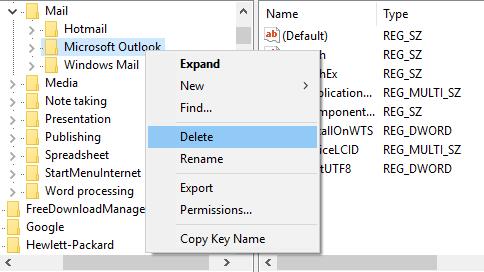

- HOW TO DELETE OUTLOOK AND REINSTALL HOW TO
- HOW TO DELETE OUTLOOK AND REINSTALL INSTALL
- HOW TO DELETE OUTLOOK AND REINSTALL WINDOWS
In rare cases, a vendor also allows a type of installation where a Windows setup is not used, but we will talk more about this later. Otherwise, an add-in might not be registered or unregistered properly, and additional work might be required to mitigate the situation. Therefore, it is strongly recommended to close all involved Office applications when installing and reinstalling. A running instance of an Office application usually loads add-ins at start-up.
HOW TO DELETE OUTLOOK AND REINSTALL INSTALL
This install procedure – in no different from any other regular software installation with the exception of user interface and contextual content – is the process where required files are copied to your computer and then registered.Ī very important note has to be made. Nowadays, the vast majority of software vendors offer their products in the form of self-installing setup files, familiar to most Windows users: Basically, software installation consists of copying certain files to your computer and registering it within the system (whether Windows, Office, or both). Like every third-party software (in contrast to out-of-the-box pre-installed Windows applications), Office add-ins need to be installed. In the next section of this article, we will use Microsoft Outlook 2013 as an example, and will take a closer look at the lifecycle of a single add-in on an individual employee’s computer, from start to finish. In addition to that – being what they are in terms of their platform-dependent nature – they could also be:īy using the controls available in their parent platform (namely a Microsoft Office application, such as Outlook or Word). They, too, have some installable components (program files), and they also can be registered as a program – along with the addition of new icons, shortcuts and segments of the interface.Ĭontinuing this analogy, just like their Windows executable counterparts, COM Add-ins can be: Structurally, COM Add-ins can be compared to regular Windows programs.
HOW TO DELETE OUTLOOK AND REINSTALL HOW TO
However – since these additional features do not add themselves, not every person working with Office may know how to use, install or manage them inside their Office applications, or even that they exist at all! The basics about managing COM Add-ins in Microsoft Office The effect of that decision to create MAPI is hard to over-estimate, and today for nearly everyone who truly depends on Microsoft Office, there is a handy add-in that can save time or improve productivity significantly. Since this parallel market has existed basically as long as the actual platform (Microsoft Office), quickly expanding alongside it, these developers have over time created innumerable add-ins, each one adding one or more functions or features to the already feature-rich applications of Microsoft Office. This timely decision led to the emergence of a whole new software market segment of third-party add-ins. The name of the actual interface is known as MAPI (or Messaging Application Programming Interface), which has been the core of the COM Add-ins system available throughout the modern Microsoft Office history, including the latest installments (Microsoft Office 2016). Their purpose was to allow third-party developers to include features of their own into Office applications.

In the days of Office 2000, certain layers of programming interfaces were introduced. Of so-called “add-ins” (also known as “add-ons”, “plug-ins”, and other variations of the word). Since the inception of its renowned suite, Microsoft has been working on addressing such niches – leading to the addition Outlook Add-ins management – introductionįor an impressively long time, the Microsoft Office suit has been the benchmark in productivity software for its versatility, popularity, practicality, and sheer number of features – so many that its reign as the de-facto standard of about two decades does not seem to be under threat at all.īut even the broadest list of features can leave specialized users desiring for more. Reporting solutions, add-ons for Microsoft Excel, Outlook Express Web Analytics, HelpDesk and Workflow solutions for SharePoint Manage signatures and disclaimers in corporate emailsĭownload emails from external POP3 servers to Exchange Multiple Exchange mailboxes search with a range of features Save, remove and manage attachments on server sideĪutomatically print emails and attachments on Exchange Server Solutions for any environment based on Microsoft Exchange Server Prints emails and attachments automaticallyĢ0 apps to improve your daily work with Outlook Personalize emails with advanced mail mergingĬovers all attachments needs: extract, ZIP, manage The line of Microsoft Outlook tools and appsġ4 add-ins in one bundle for the best priceįinds and removes duplicated in emails and postsįinds and removes duplicated contacts, tasks, etc


 0 kommentar(er)
0 kommentar(er)
